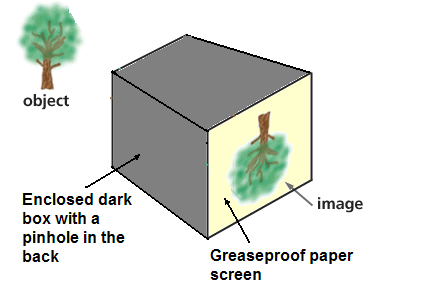|
Straight
Path for Light  Light travels in straight lines - as long as it is not interacting with anything! In a vacuum it will travel in a straight line at a constant speed, c (for constant!), called (appropriately enough) the speed of light, where c = 3.0 x 108 m/s = 300,000,000 m/s (about 186,000 miles per second!) It sometimes changes direction when it encounters a different substance (or the substance it is travelling through changes density. It can either be: So, if there is a gap for it to travel though, it will travel through in a straight line. Only the light that interats with the edge of the gap will be affected by it - see diffraction. All visible objects either emit light or reflect light. Some do both, most just reflect. The way that we "see" things is by responding to the light that is reflected off of them into our eyes. When an object either emits light or reflects it, the light travels in all directions from the object. Only a tiny fraction of the light from the object gets into our eyes at one time - the pupil is a very tiny aperture! Imagine a tree off in the distance. We may focus our eyes on the top branches of the tree but light from the trunk and the branches facing us is still traveling into our eyes. The rays have to travel through the tiny aperture in the iris - the pupil.
Take a carboard box (or an empty can - with the top taken off so that there are no sharp edges!) and replace one side with a greaseproof paper screen. Hold it so that you are pointing the pinhole end towards a brightly lit object (perhaps a sunlit tree through a window) and you will see the image formed on the screen. The diagram below shows why the image is upside down! Since the pinhole is so small, only a tiny proportion of rays from top branch can pass through the hole. Their path is indicated by the green line. These light rays haven't encountered any different media, so they travel in a straight path from the tree branch to the screen. The same is true for rays from the bottom of the tree (brown line)
The retina cells at the top of your eye get image information from the lower part of an object you are looking at and the cells at the bottom from the top of the object. Why don't you see images upside down?
What would happen if we made the pinhole bigger?
|
Follow me...
|


 The
same happens with the a pinhole camera and the light source.
The
same happens with the a pinhole camera and the light source. Notice
that the rays from the top branch and from the trunk have to cross at
the pinhole in order to pass through. This is what causes the image of
the tree (or light bulb, or any other object) to be upside down
Notice
that the rays from the top branch and from the trunk have to cross at
the pinhole in order to pass through. This is what causes the image of
the tree (or light bulb, or any other object) to be upside down


